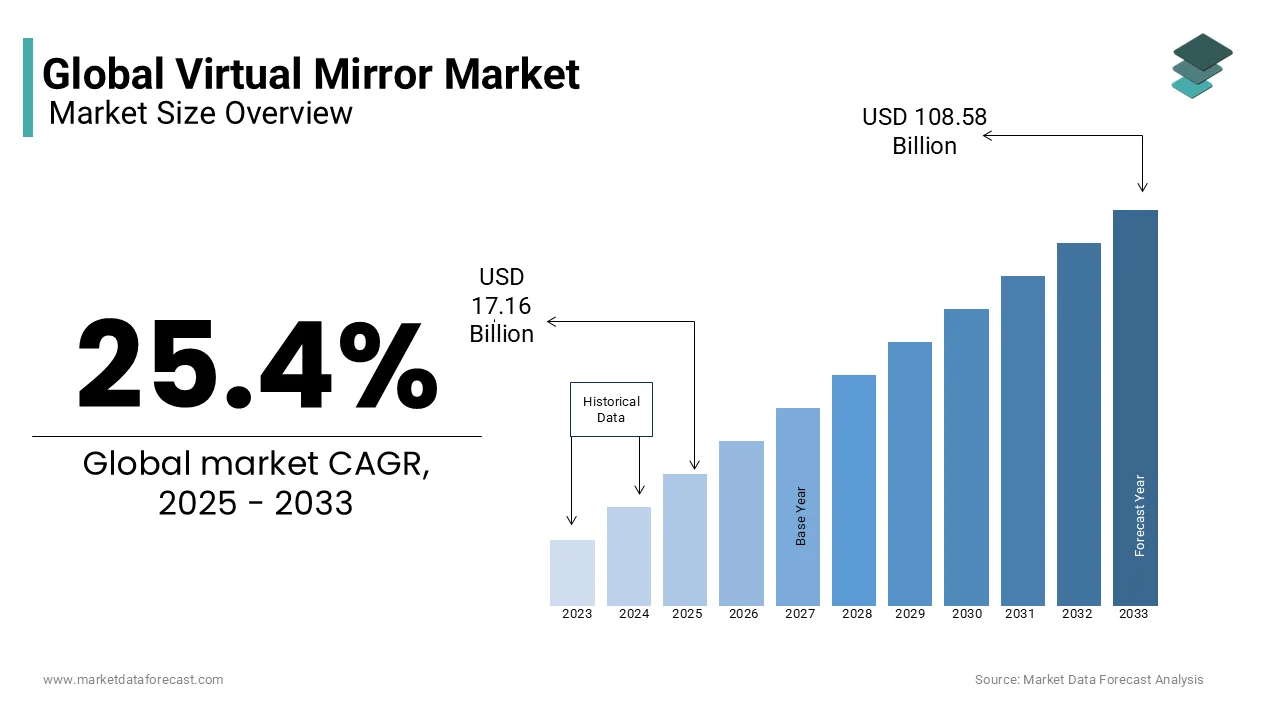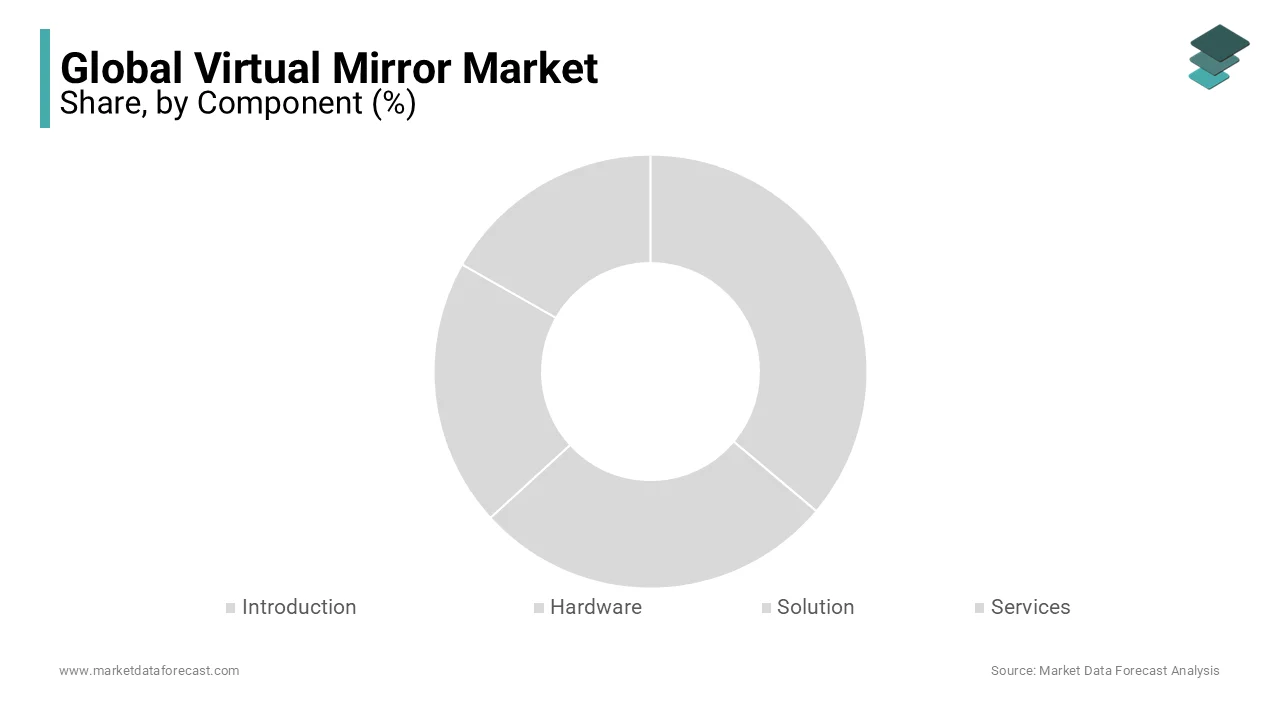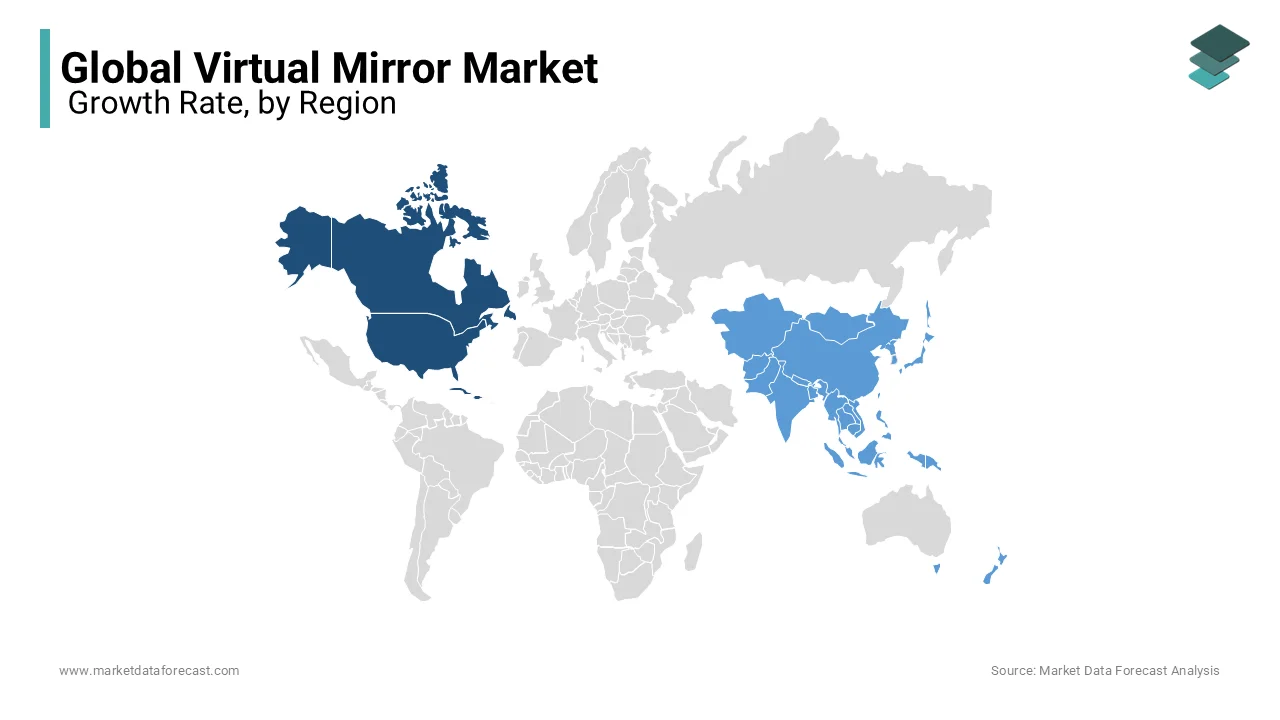Global Virtual Mirror Market Size, Share, Trends, & Growth Forecast Report by Component (Hardware, Solution, Services), Technology (3D Body Scanning, Photo Accurate VFR, 3D Augmented Reality & Virtual Reality), Industry (Retail) & Region, Industry Forecast From 2024 to 2033
Global Virtual Mirror Market Size
The global virtual mirror industry was worth USD 14.16 billion in 2024. The global market is projected to hit USD 17.16 billion in 2025 at a pace of 25.4%. It is further forecasted to grow to USD 108.58 billion by 2033 during the forecast period 2025 to 2033.

Current Scenario of the Global Virtual Mirror Market
The virtual mirror market growth is projected to emphasize factors such as ease of testing clothing in a virtual business environment, increased hygiene for cosmetic products and other retail products, and virtual product testing in the e-commerce platform before purchasing. In addition, the introduction of multi-sensor body scanners has revolutionized the shopping experience with online platforms. The growth of e-commerce is expected to provide virtual mirror solution providers with great potential to grow.
In the automotive industry, a digital exterior mirror is commonly used since it provides a practical view of the wide-angle camera and the LCD in the vehicle. Their adoption and deployment are projected to be further increased, reassuring the industry about its benefits. The use of an external digital mirror in cars helps automakers reach seasoned buyers while at the same time raising vehicle costs. The use of interactive mirrors with LCD screens in the hotel sector is becoming more common because they integrate text on the monitor and video content to engage and entertain customers in the hospitality sector, providing a practical solution for customer engagement.
MARKET DRIVERS
Digital mirror manufacturers offer a wide range of products to retailers in brick & mortar shops and e-commerce sites. The market is mainly comprised of start-up firms investing in technology for increasing reality (AR) and virtual reality (VR) and for artificial intelligence (AI). These start-ups have received substantial financial support, instilling confidence in the market's stability and potential for growth. To develop and market their products, companies offering cost-efficient and creative digital mirror solutions have been bolstered by this support. As mentioned, automotive providers joined the virtual space with solutions like a digital side/outside mirror and a virtual windscreen.
Customers can check clothes and accessories, share photos, and compare different objects digitally via a photo scope or body 3D using kiosks and web portals with AR, VR, AI, facial recognition, and 3D body scanning technology. The better use of a virtual mirror is mainly attributable to the need to determine customer preferences and test clothes without wearing clothes. Hardware components, including cameras, sensors, and display systems, are integral to a virtual mirror in a brick-and-mortar shop fitting room.
Research Methodology
Market research involves studying market trends and growth patterns and understanding the influence of macro and microeconomic conditions, geopolitical conditions, and demographic conditions on market value and market dynamics.
The research methodology used to calculate and forecast the Virtual Mirror market began by collecting information on the market key players' sales using multiple sources via secondary research. Supplier offers have been considered to identify market segmentation.
REPORT COVERAGE
|
REPORT METRIC |
DETAILS |
|
Market Size Available |
2024 to 2033 |
|
Base Year |
2024 |
|
Forecast Period |
2025 to 2033 |
|
CAGR |
25.4% |
|
Segments Covered |
By Component, Technology, Industry, And Region |
|
Various Analyses Covered |
Global, Regional & Country Level Analysis, Segment-Level Analysis, DROC, PESTLE Analysis, Porter’s Five Forces Analysis, Competitive Landscape, Analyst Overview on Investment Opportunities |
|
Regions Covered |
North America, Europe, APAC, Latin America, Middle East & Africa |
|
Market Leaders Profiled |
Astrafit, DigitalDM, Fitnect Interactive, International Business Machine Corporation, Metail Limited, MemoMi Labs Inc., SenseMi, Virtual, Zugara, Inc., 3D-A-porter, and others. |
SEGMENTAL ANALYSIS
By Component Insights

By Technology Insights
The global market is divided into software, hardware, and services based on the components. The market share of the technology category over the forecast period shall be the highest. The need for interactive visual interfaces on dedicated hardware systems such as kiosks and mirrors can be attributed to the demand for software. The software ensures a compatible display of clothing and accessories in a virtual world on applications and websites. For example, L'Oreal deployed an AR virtual mirror that can provide the effect and feel of the actual product with the help of a virtual makeup attempt.
By Industry Insights
The virtual mirror market is divided into consumer and other demands based on industry. The retail sector is further divided into e-commerce and brick-and-mortar based on the type of distribution channel. In retail, a digital mirror is typically called a memory mirror or an intelligent reflector. Such mirrors boost the consumers' experience in in-store and online shopping. For instance, Nike has an in-store customer, allowing consumers to digitally model a pair of sneakers. In 2018, there was a significant market share in the retail segment, and the projected period is expected to show high growth.
REGIONAL ANALYSIS
The highest percentage of sales over the forecast period is expected in North America. The USA is a focal point of the largest retail brands and hotel chains, boosting demand in the country for virtual mirrors. However, the US Government has categorized virtual side mirrors under the mirrorless section as an obstruction in the automotive industry. In the Asia Pacific area, the development of online shopping is projected to be the highest in the next six years. Countries like China, Japan, and India are major car and retail hub countries that currently experience rising demand for digital mirrors.

KEY PLAYERS IN THE MARKET
Astrafit, DigitalDM, Fitnect Interactive, International Business Machine Corporation, Metail Limited, MemoMi Labs Inc., SenseMi, Virtual, Zugara, Inc., and 3D-A-porter are leading companies providing virtual mirror solutions with core expertise in AR / VR-based solutions. These companies offer various virtual mirror services supported by advanced technologies to support different stages of the product life cycle and offer a product solution end-to-end. The businesses opt for alliances and conferences to present their goods.
RECENT HAPPENINGS IN THE MARKET
- With Cisco's Innovation & Experience Centre (IXC), SenseMi partnered in May 2018 to demonstrate their digital mirror solutions.
- Metail Limited joined Princess Polly in 2017 to enter the Australian market to satisfy online shoppers' needs.
Key highlights of the research report
- This report provides a detailed quantitative analysis of the current market and estimates for 2024-2029, which help identify the prevailing market opportunities.
- Important changes in market dynamics.
- Report and evaluation of recent developments in the industry.
- Competitive intelligence helps to understand the competitive scenario in geographical regions.
- This report describes the key players in the market in detail and analyzes their strategies in depth to better understand the market's competitive advantage.
MARKET SEGMENTATION
This research report on the global virtual mirror market has been segmented and sub-segmented based on the component, technology, industry, and region.
By Component
- Introduction
- Hardware
- Solution
- Services
By Technology
- Introduction
- 3D Body Scanning
- Photo Accurate VFR
- 3D Augmented Reality
- Virtual Reality
By Industry
- Introduction
- Retail
By Region
- North America
- Europe
- Asia Pacific
- Latin America
- Middle East and Africa
Frequently Asked Questions
What are the primary factors driving the growth of the virtual mirror market globally?
The growth of the global virtual mirror market is primarily driven by increasing adoption of augmented reality (AR) and virtual reality (VR) technologies across various industries, particularly in retail, fashion, and beauty sectors.
How are advancements in AI influencing the virtual mirror market worldwide?
Advancements in artificial intelligence (AI) are enhancing the capabilities of virtual mirrors, enabling personalized recommendations, virtual try-on experiences, and real-time analysis of customer preferences, thereby driving market growth globally.
What are the key challenges faced by the virtual mirror market globally?
Some of the key challenges include concerns regarding privacy and data security, high initial investment costs for businesses, and technological limitations in achieving realistic virtual try-on experiences.
How do regulations and standards vary for virtual mirror technologies across different regions worldwide?
Regulations and standards governing virtual mirror technologies vary across regions, with some countries having specific guidelines for data privacy, content moderation, and consumer protection, which companies need to comply with to operate in those markets globally.
Related Reports
Access the study in MULTIPLE FORMATS
Purchase options starting from $ 2500
Didn’t find what you’re looking for?
TALK TO OUR ANALYST TEAM
Need something within your budget?
NO WORRIES! WE GOT YOU COVERED!
Call us on: +1 888 702 9696 (U.S Toll Free)
Write to us: [email protected]